Parallel Lines: Pete McAfee
Check out the rest of the Parallel Lines series here.
Name: Pete McAfee
Primary 23/24 Season Terrain: Mt Ashland Ski Area + the southern Oregon backcountry
Sport: Three-track ski mountaineering
An amputee since childhood, after a birth defect left one of his legs significantly shorter than the other, Pete McAfee is no stranger to prosthetics. “I made a lot of trips to Dallas from Midland as a kid to get one that fit me correctly every year,” he recalls.
“At that time, the insurance that my parents had covered one prosthetic per lifetime. But obviously my stump was growing and outgrowing the socket; it wasn’t just the height discrepancy.” So the family traveled to a hospital further afield that had a program they qualified for that helped with the associated (and astronomical) costs of additional ones.
Pete’s relationship with winter sports equipment, however, began much more recently:
“I was totally happy living in West Texas, living this sheltered little life with nothing to do.” Pete laughs. When his wife suggested (insisted upon) switching things up by moving to Medford, OR, in 2009, that all changed.
“It opened up a whole world of mountains, rivers, and surf,” he says. It also opened up a whole world of trials, tribulations and triumphs related to the gear with which Pete began to experiment.
“When I first started skiing, I just squeezed my prosthetic foot into a ski boot.” Pete tried everything from stuffing towels to water bottles in the boot to get rid of the space around his prosthetic ankle, but, unsurprisingly, nothing was ever quite perfect.
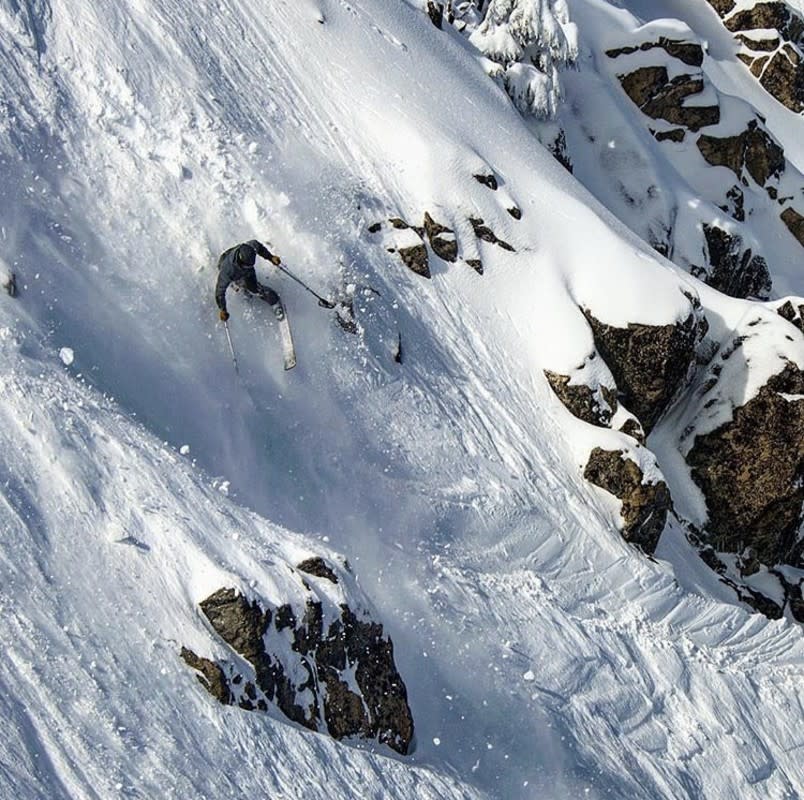
Photo courtesy of Pete McAfee
“On top of that, there was also always rotational play in my socket; it doesn’t fit real well on my stump. I never had great control of that ski. It was just an accident waiting to happen.”
And happen it did, one day while skiing at Mt. Shasta. Pete’s tips crossed thanks to that above-mentioned rotational play while he was “going way too fast like a typical Texan.” The resulting crash resulted in an open tibia fracture on his residual limb.
“I didn’t really want to wait to start skiing again after that,” Pete grins sheepishly. So he braced his surgically-repaired injury with wooden dowels and duct tape (“for extra protection”) and got back on snow. But rather than tempt fate on two skis again, Pete opted to try riding just one.
“It was better than skiing on the prosthetic because at least I had total control.” But getting through transitional zones without a second ski and while using just his standard ski poles was an arduous affair.
“Then, at Mt. Bachelor one day, some three-tracker skied up to me and said ‘Dude, you’re an idiot. Oregon Adaptive Sports is right over there. Go down and get a pair of outriggers. It’ll make your life so much better.’ So I did. And it was full on from there.”
Pete says he never caught that brusque, good Samaritan’s name. “He didn't actually have anything to do with Oregon Adaptive and he didn’t even really wanna talk. But he changed my trajectory big time. He made me realize there are people like me who do this out there.”
With Pete’s experience on both one and two skis already behind him, the outriggers became the final major piece to his skiing puzzle. Like a tightrope walker using a pole for balance, Pete says his outriggers now serve a similar purpose. They also make a night and day difference in managing uphills and flats.
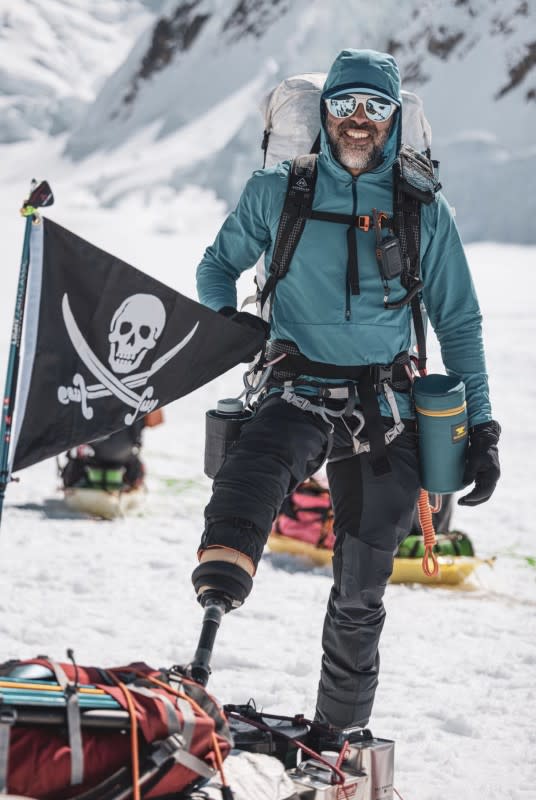
Photo courtesy of Pete McAfee
Pete’s quick to correct a common misconception that his outriggers serve as additional edges while carving or as more float in powder, though: “On groomers, outriggers are great. You’ve got feelers out. But in powder, you don’t put them down because if you let them dive at all they’re like a parachute - they’re gonna grab the snow and rip your arm behind you and send you head first into the snow over the front of your ski. I figured that out immediately,” he laughs.
“I do use my outriggers on really steep terrain when I have to do hop turns,” Pete adds, alluding to the fact that, at this stage in his snow sport career, his primary focus is ski mountaineering. “I plant an outrigger and then hop turn around it. So they are very useful in that situation.”
Ski mountaineering might not have been on this flat-lander’s radar until recently, but it’s now what Pete lives for. He ruefully credits a cervical spine injury, which left him unable to lift more than five pounds for a year, with getting him into hiking one summer. “Then I started climbing mountains in the winter and it became my all out focus.
And ski mountaineering has presented Pete with a whole new set of gear-related problems to solve.
“I used to just carry an ice axe on the uphill and throw my outriggers in my pack,” Pete throws out as an example.”On the down, I would try to ski-strap my ice axe to my outrigger. But I never felt like that would actually self-arrest me in a real situation.”
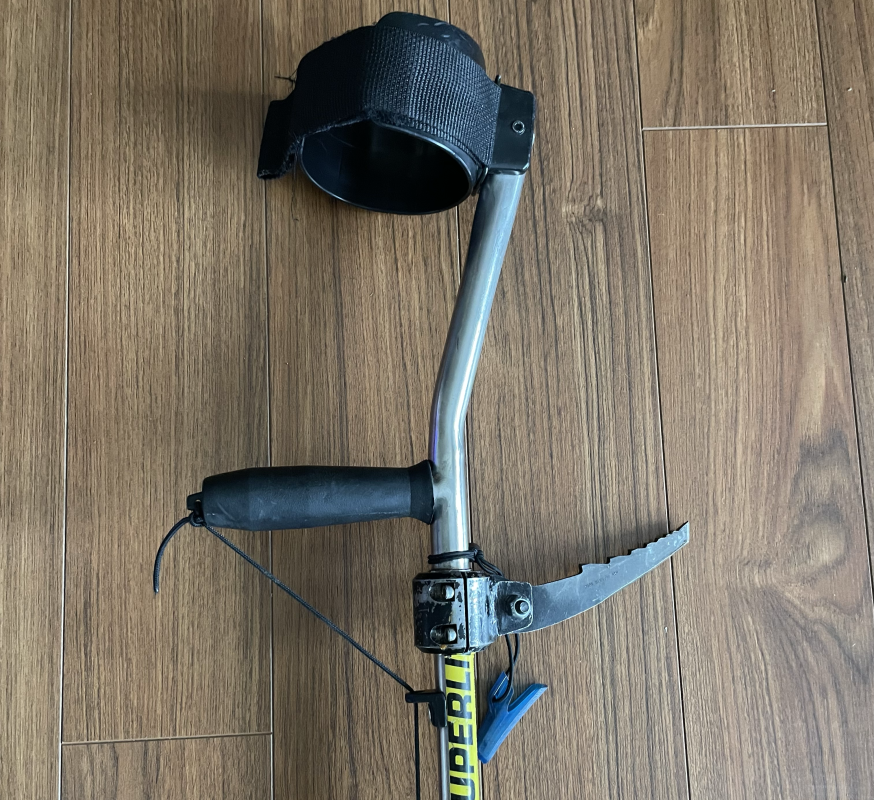
Photo courtesy of Pete McAfee
After seeing the setup fellow three-tracker Vasu Sojitra uses, however, Pete realized he could weld his ice axe picks directly to his titanium outriggers, into a unique item Pete now cheerfully calls “the Death Pick.”
Because Pete’s Death Pick isn’t something he can find through any gear manufacturer (yet), he says he’s grateful for Vasu’s guidance and the work Vasu put in prototyping the system. “You’re just going to a machinist saying: ‘Hey I need this welded onto this clamp and I need a bushing to make this clamp fit this.’ I only nailed it in one because I piggybacked off Vasu.”
Beyond his outriggers, Pete also tinkers with his prosthetic attachments. He explains that since his insurance won’t buy anything but “the most generic, geriatric” prosthetic, he’s taken making and modifying his feet into his own hands.
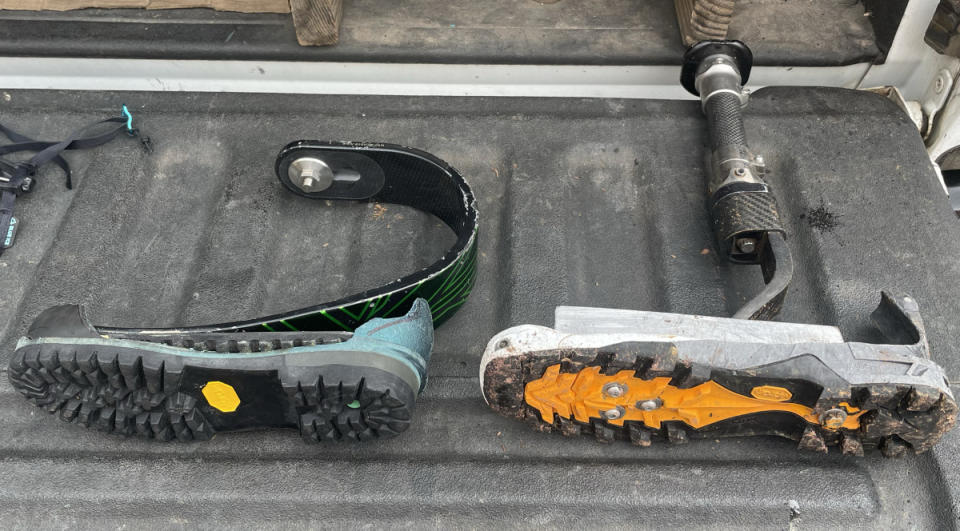
Photo courtesy of Pete McAfee
“My whole life I’ve been trying to tell [my insurance company] that the standard foot doesn’t move, is heavy, has no return, puts pressure on my back, hip and knee and throws my butt out in a way that gives me a weird gate that’s uncomfortable and not good for me. I keep telling them there’s better stuff out there, but they just say the alternatives are ‘sport-specific.’ My point is that they could and should be daily drivers.”
So Pete has gotten creative in the meantime.
“I’ll take any old prosthetic foot I can get that’s old and junked, that I can pull different parts off, and I'll just bolt ‘em together. Then, I’ll get old ski boots from the ski swap that would be trashed, and I cut the soles off those and bolt them onto my prosthetic Frankenstein boot. Basically all I'm doing is making it so that the foot is compatible with a crampon, a vert, or a drift plank.”
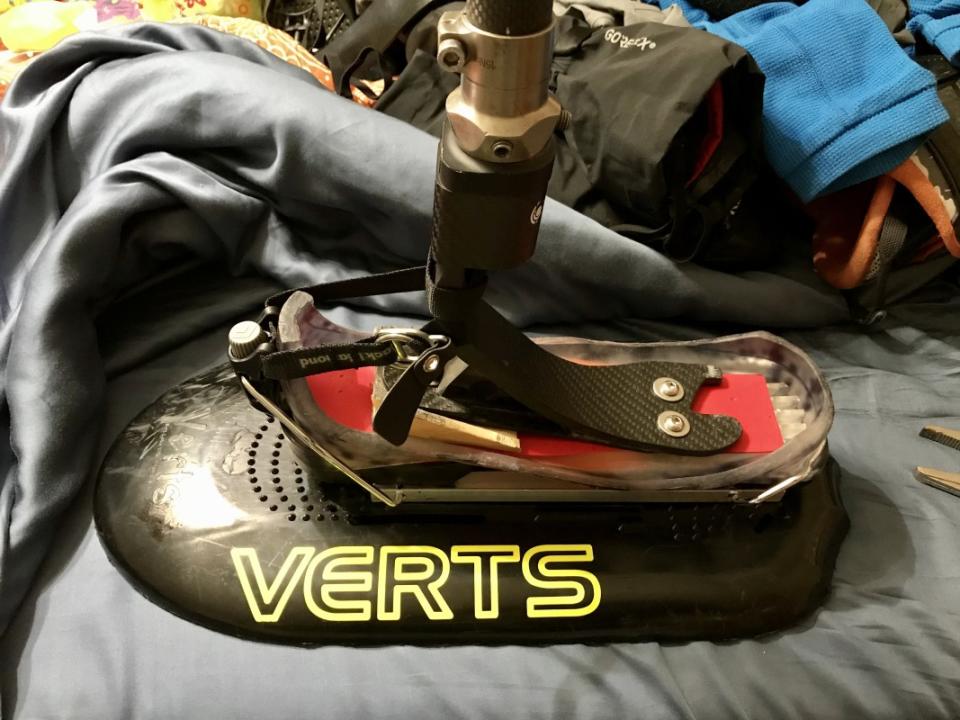
Photo courtesy of Pete McAfee
“I definitely dream of a prosthetic foot that is lightweight, crampon compatible and tour binding compatible for ski mountaineering. But I guess my sketchy, home-modified setup will work for now,” he says dryly.
“Right now I have two feet. One is flexy and easy to walk in and easy on my joints for mellow ridge work and mountaineering. The other is just an absolute brick that is horrible to walk on but for ice climbing scenarios, it’s absolutely crucial because I don’t want any flex in that ankle.”
Which means that, depending on the mission, Pete has a quiver of combinations to choose from. “If I'm just going out to climb Mt McLoughlin or Adams, I'll usually just take one ski on one foot and I'll put a drift plank on the other to save weight, and also because skiing down with a ski on your back sucks. It’s actually okay in the alpine, but once you get down to treeline, you gotta be really really cautious where you make turns,” he laughs.
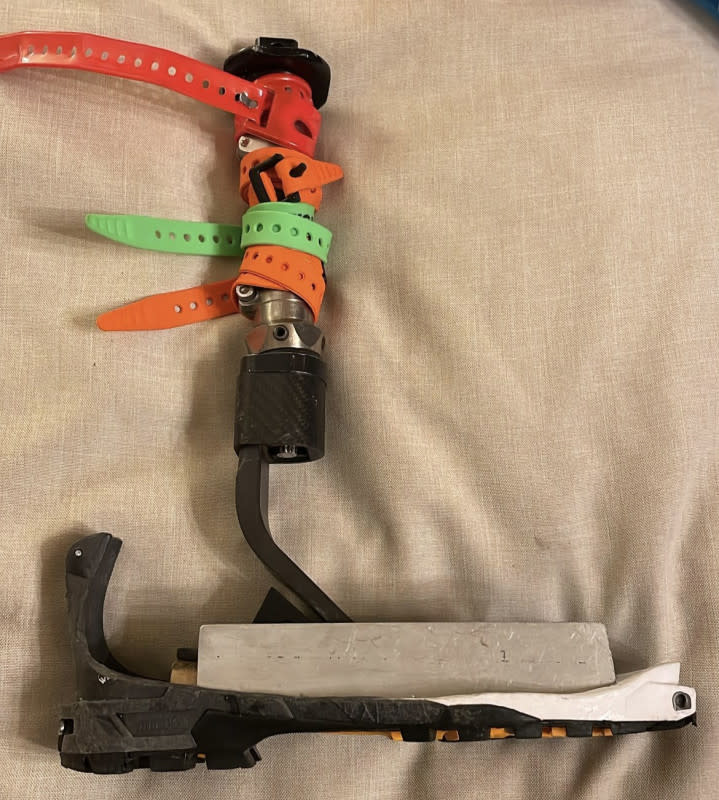
Photo courtesy of Pete McAfee
“If I’m on an expedition, though, I can actually skin in on two different skis.” Pete uses his 2021 trip to climb and ski Mt Denali with Vasu as an example. “I took one ski with a smaller waist and one ski that was a fatty and I was the only one that had a quiver when we got to camp.”
“I don’t do snowshoe attachments for my outriggers or anything because being able to use my prosthetic for the uphill is awesome. I’m fortunate in that I can pretty well do uphill stuff the way that any able-bodied person would. I just have to modify my gait. Kickturns can be a little tricky, but I've got it figured out.”
Pete says he gets most of his skis from friends and peers who have either broken or lost a ski and no longer have a need for the second half of the pair. He perks up when the idea of an adaptive community gear exchange arises: “I haven’t found anybody that helps folks swap around gear but that would be awesome because boots are expensive and skis are expensive and every time I get a boot or a ski I’ve got a second brand-new one that’s just gonna sit there.”
One ski Pete’s particularly excited about that is not a hand-me-down, however, is his “custom monster fatty.” Tired of only ever having half the floatation of two-legged skiers, Pete reached out to several monoski companies to see if they’d make a slimmed down version of one of their models for him to use on his residual limb.
After a couple companies declined (expressing concerns over how far Pete’s ankle would be from the ski’s edge), Coda Custom Boards out of California agreed to give Pete’s vision a go. The result? A full rocker, bamboo core ski that’s 210mm at the shovel, 160mm underfoot, 180mm on the tail and 190mm in length.
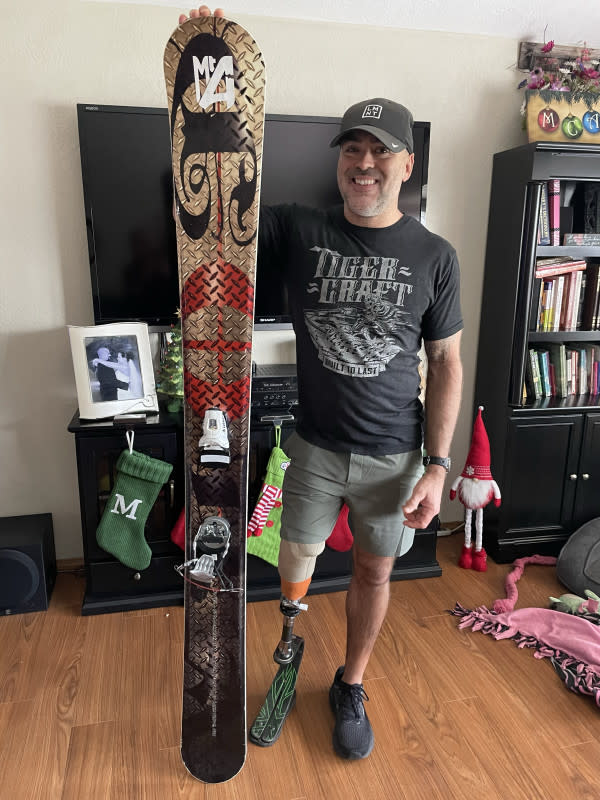
Photo courtesy of Pete McAfee
Pete’s almost giddy describing how it rides: “It’s basically like being on a snowboard facing down the fall line. I wanted to know what it is to make big, surfy turns and tail whip to slap and throw pow and slow down, and that’s exactly what this ski lets me do. If it’s a powder day, hands down, it’s my go-to.”
So far as Pete knows, Coda hasn’t made another ski like it for anyone else, but he’ll tell any adaptive skier that’ll listen that getting one, too “will change everything.
“It’s not ‘skiing,’ necessarily,” he laughs, “but it’s a lot of fun.”
Big goals are just as much a part of Pete’s personality as his big ski, and he says he’s always training, “just grinding and carrying rocks up mountains,” waiting for the next project to come along. “Ever since Denali I’ve tried to line something up but the right crew didn’t come together or the financial burden was such that I couldn’t afford to go.”
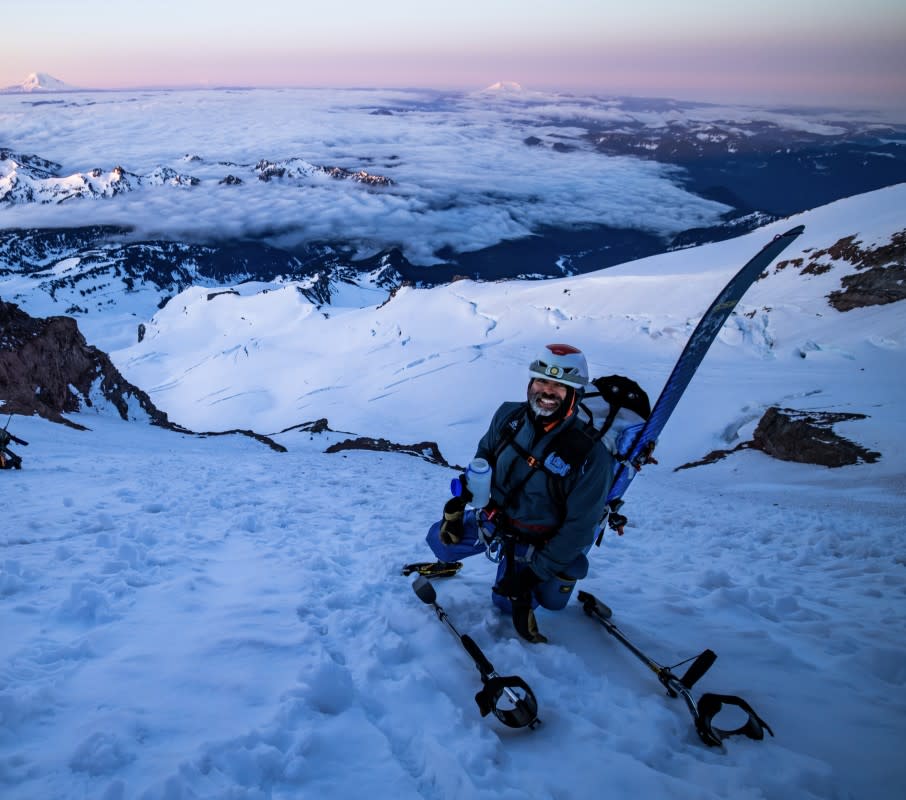
Photo courtesy of Pete McAfee
Opportunity finally knocked recently in the form of an online competition to join an expedition to climb Aconcagua, the second-highest of the Seven Summits, in January. Pete submitted an application. And won.
“It’s not a ski mission, which I kinda wish it was,” he admits laughingly, “but it’s great.” Pete says that he’s almost as excited about the nature of the trip than the mission itself. “I don’t know anybody on the team, I’ll be the only adaptive athlete in the group, and it’s not a film project or anything. So it’s just for me, with no extra stress put on it.”
To follow along as Pete prepares for his trip to South America and to see him and his gear in action, find him on Instagram @plp_mcafee.

